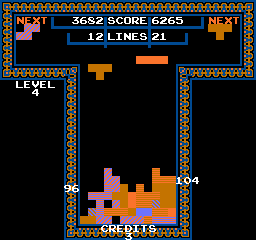
Vs. Tetris © 1988 Atari Games.
Main CPU : Zetex N2A03 (@ 1.789772 Mhz)
Sound Chips : Zetex N2A03 (@ 1.789772 Mhz), DAC (@ 1.789772 Mhz)
Screen orientation : Horizontal
Video resolution : 256 x 240 pixels
Screen refresh : 60.00 Hz
Palette colors : 64
Players : 2
Control : 8-way joystick
Buttons : 2
Inspired by a pentominoes game he had bought earlier, Alexey Pajitnov creates Tetris on an Electronica 60 in June 1985 at the Moscow Academy of Science's Computer Center. It is ported to the IBM PC by Vadim Gerasimov and starts spreading around Moscow. Pajitnov gets a small degree of fame for his program. Due to Soviet political structure at the time, the inventor, Alexey Pajitnov was not able to patent his game. This gave rise to many sundry Tetris clones for all manner of machines.
Here is the name of all tetrominos in Tetris (A tetromino is a geometric shape composed of four squares, connected orthogonally) :
* The 'I' (Also called 'Stick' or 'Straight') - Four blocks in a straight line.
* The 'Square' (Also called 'O', 'Package' or 'Block') - Four blocks in a 2x2 square.
* The 'T' - A row of three blocks with one added below the center.
* The 'L' - A row of three blocks with one added below the left side.
* The 'J' (Also called 'Inverted L' or 'Gamma') - A row of three blocks with one added below the right side (This piece is a reflection of 'L' but cannot be rotated into 'L').
* The 'S' - Bent trimino with block placed on outside of clockwise side.
* The 'Z' (Also called 'Inverted S') - Bent trimino with block added on outside of anticlockwise side (This piece is a reflection of 'S' but cannot be rotated into 'S').
Apart from being a fine game, Tetris is also a perfect mirror of the human condition. For a while the game is entertaining, and we seem to have mastered it and are having fun. Then, something goes wrong. A rash mistake, or an unfulfilled wish, and we're fighting to repair the damage, but we've been thrown off-balance, and the cancer is spreading. Blocks that were once orderly and harmonious are jumbled and filled with holes, and our cup is on the verge of running over. There's always a point at which we stop planning for the future, and realize that we don't have one - all we can do is cling to the present and concentrate, focus our minds on what it's like to be alive, to play the game, before it's all over. You were waiting for a four-by-one block that never came. Eventually we stare death in the face, and death will not spare us because we would warn the others to stay away and not play the game. Sometimes we resist to the bitter end, moving blocks left and right without thought or care, just to hang on, and sometimes we accept the inevitable and pull the blocks down to us, smiling inwardly at the great joke. The rest is silence. We admire the fox as it escapes from the hounds, but when the hunt is over we turn away, and go off and drink and be merry, and somewhere else someone or something is watching us as we watch the fox. But the fox knows it is being chased.
Tetris falls in the same class of tantalizing problems as the famous Traveling Salesman Problem or the Halting Problem. It's the intellectual challenge of coming up with heuristics to crack the game that make it so addictive.
Tetris was first released in Japan by Bullet Proof Software (BPS), they got the license from Mirrorsoft and Tengen, Tengen also got the license from Mirrorsoft. Mirrorsoft claimed to have the rights of Tetris because its president got a copy of the original Tetris code by Pajitnov himself, however, there were no legal contracts at all. After Nintendo legally got the rights for Tetris from Pajitnov and ELORG in a trip to the USSR and was proven that Mirrorsoft wasn't legally entitled to give licenses, Tengen's unlicensed Tetris for the NES was recalled and Sega's version was called Tetremix for the soundtrack CD's. BPS (which had registered Tetris in Japan which made Nintendo's version not to be released there) eventually got the rights for Tetris and even had Pajitnov as an employee. Nowadays, Pajitnov runs the Tetris Company, any company that wants to make a Tetris game has to get the license from (and only from) this company.
Game's ROM.